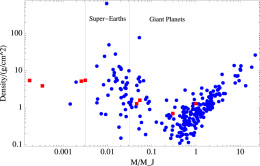To date, we’ve discovered nearly 2000 confirmed exoplanets, as well as thousands of additional candidates. Amidst this vast sea of solar systems, how special is our own? A new study explores the answer to this question.
Analyzing Distributions
Knowing whether our solar system is unique among exoplanetary systems can help us to better understand future observations of exoplanets. Furthermore, if our solar system is typical, this allows us to be optimistic about the possibility of life existing elsewhere in the universe.
In a recent study, Rebecca Martin (University of Nevada, Las Vegas) and Mario Livio (Space Telescope Science Institute) examine how normal our solar system is, by comparing the properties of our planets to the averages obtained from known exoplanets.
Comparing Properties
So how do we measure up?
- Planet masses and densities

Densities of planets as a function of their mass. Exoplanets (N=287) are shown in blue, planets in our solar system are shown in red. [Martin&Livio 2015]
Those of the gas giants in our solar system are pretty typical. The terrestrial planets are on the low side for mass, but that’s probably a selection effect: it’s very difficult to detect low-mass planets. - Age of the solar system
Roughly half the stars in the disk of our galaxy are younger than the Sun, and half are older. We’re definitely not special in age. - Orbital locations of the planets
This is actually a little strange: our solar system is lacking close-in planets. All of our planets, in fact, orbit at a distance that is larger than the mean distance observed in exoplanetary systems. Again, however, this might be a selection effect at work: it’s easier to detect large planets orbiting very close to their stars. - Eccentricities of the planets’ orbits
Our planets are on very circular orbits — and that actually makes us somewhat special too, compared to typical exoplanet systems. There is a possible explanation though: eccentricity of orbits tends to decrease with more planets in the system. Because we’ve got eight, it might be unsurprising that their eccentricities are so low. - Super-Earths
We don’t have any planets in the range of 1-10 times the mass of Earth, which is pretty unusual — super-Earths have a high occurrence rate among exoplanets.
In summary, the authors find that for the most part, we’re a pretty typical solar system. Our most unusual features are the lack of a super-Earth, the lack of any close-in planets, and the low eccentricities of our planets. The fact that we’re fairly average means that, from a habitability standpoint, there’s probably nothing special about our little corner of the galaxy. So perhaps life elsewhere is a possibility!
Citation
Rebecca G. Martin and Mario Livio 2015 ApJ 810 105. doi:10.1088/0004-637X/810/2/105

9 Comments
Pingback: Outside in - Involvements with reality » Blog Archive » Chaos Patch (#82)
Pingback: Rarity of Jupiter-like planets means planetary systems exactly like ours may be scarce | Big Fat Web
Pingback: Rarity of Jupiter-like planets means planetary systems exactly like ours may be scarce - Ecomentality
Pingback: Rarity of Jupiter-like planets means planetary systems exactly like ours may be scarce | Synthetic Worlds
Pingback: Rarity Of Jupiter-Like Planets Means Planetary Systems Exactly Like Ours May Be Scarce | Space Leaks | Space & Astronomy News
Pingback: Look for ‘Jupiters’ to Find Solar Systems Like Ours (Op-Ed) | News
Pingback: Look for 'Jupiters' to Find Solar Systems Like Ours (Op-Ed) | Space science
Pingback: Look for 'Jupiters' to Find Solar Systems Like Ours (Op-Ed) | NewsB2
Pingback: Rarity of Jupiter-like planets means planetary systems exactly like ours may be scarce - Flavible